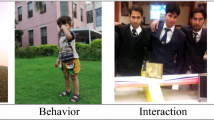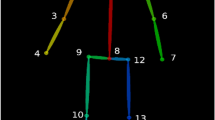Abstract
Gait recognition is one of the most important techniques in application areas such as video-based surveillance, human tracking and medical systems. In this study, a novel Gabor wavelets based gait recognition algorithm is proposed, which consists of three steps. First, the gait energy image (GEI) is formed by extracting different orientation and scale information from the Gabor wavelet. Secondly, A two-dimensional principal component analysis ((2D)2PCA) method is employed to reduce the feature space dimension. The (2D)2PCA method minimizes the within-class distance and maximizes the between-class distance. Last, the multi-class support vector machine (SVM) is adopted to recognize different gaits. Experimental results performed on CASIA gait database show that the proposed gait recognition algorithm is generally robust, and provides higher recognition accuracy comparing with existing methods.











Similar content being viewed by others
References
Aggarwal H, Vishwakarma D (2017) Covariate conscious approach for Gait recognition based upon Zernike moment invariants. IEEE Transactions on Cognitive and Developmental Systems
Arora P, Srivastava S (2015, February) Gait recognition using gait Gaussian image. In: IEEE 2015 2nd International Conference on Signal Processing and Integrated Networks (SPIN), pp 791–794
Chen Y, Yang J, Wang C, Liu N (2016) Multimodal biometrics recognition based on local fusion visual features and variational Bayesian extreme learning machine. Expert Syst Appl 64:93–103
Choudhury SD, Tjahjadi T (2015) Robust view-invariant multiscale gait recognition. Pattern Recogn 48(3):798–811
Daugman JG (1985) Uncertainty relation for resolution in space, spatial frequency, and orientation optimized by two-dimensional visual cortical filters. JOSA A 2(7):1160–1169
Donohue L (2012) Technological leap, statutory gap, and constitutional abyss: remote biometric identification comes of age. Minnesota Law Review 97:407–559
Ekinci M, Aykut M (2007) Human gait recognition based on kernel PCA using projections. J Comput Sci Technol 22(6):867–876
Guan Y, Wei X, Li CT, Keller Y (2014) People identification and tracking through fusion of facial and gait features. In: Biometric Authentication. Springer International Publishing, pp. 209–221
Gupta JP, Singh N, Dixit P, Semwal VB, Dubey SR (2013) Human activity recognition using gait pattern. International Journal of Computer Vision and Image Processing (IJCVIP) 3(3):31–53
Han J, Bhanu B (2006) Individual recognition using gait energy image. IEEE Trans Pattern Anal Mach Intell 28(2):316–322
Hossain E, Chetty G (2013, November) Multimodal Feature Learning For Gait Biometric Based Human Identity Recognition. In: Neural Information Processing. Springer Berlin Heidelberg, pp. 721–728
Huang DY, Lin TW, Hu WC, Cheng CH (2013) Gait recognition based on Gabor wavelets and modified gait energy image for human identification. J Electron Imaging 22(4):043039
Islam MS, Islam MR, Hossain MA, Ferworn A, Molla MKI (2017) Subband entropy-based features for clothing invariant human gait recognition. Advanced Robotics 1–12
Iwama H, Muramatsu D, Makihara Y, Yagi Y (2013) Gait verification system for criminal investigation. IPSJ Transactions on Computer Vision and Applications 5:163–175
Kejun W, Tao Y, Zhuowen L, Mo T (2013) Kernel sparsity preserving projections and its application to gait recognition. Journal of Image and Graphics 18(3):257–263
Liu N, Tan YP (2010, March) View invariant gait recognition. In Acoustics Speech and Signal Processing (ICASSP), 2010 I.E. International Conference on (pp 1410-1413). IEEE
Lu J, Wang G, Moulin P (2014) Human identity and gender recognition from gait sequences with arbitrary walking directions. IEEE Trans Inf Forensics Secur 9(1):51–61
Luo C, Xu W, Zhu C (2015, September) Robust gait recognition based on partitioning and canonical correlation analysis. In: Imaging Systems and Techniques (IST), 2015 I.E. International Conference on (pp 1–5). IEEE
Milovanovic M, Minovic M, Starcevic D (2012, November) New gait recognition method using Kinect stick figure and CBIR. In: IEEE 2012 20th Telecommunications Forum (TELFOR), pp 1323–1326
Nandy A, Chakraborty P (2015, August) A new paradigm of human gait analysis with Kinect. In: IEEE 2015 Eighth International Conference on Contemporary Computing (IC3), pp 443–448
Preis J, Kessel M, Werner M, Linnhoff-Popien C (2012, June) Gait recognition with kinect. In: 1st international workshop on kinect in pervasive computing. New Castle, pp. P1–P4
Raheja JL, Chaudhary A, Nandhini K, Maiti S (2015) Pre-consultation help necessity detection based on gait recognition. SIViP 9(6):1357–1363
Ren Y, Wang Z, Chen Y, Zhao W (2015) Sparsity preserving discriminant projections with applications to face recognition. Math Probl Eng 501:203290
Tang J, Luo J, Tjahjadi T, Guo F (2017) Robust arbitrary-view gait recognition based on 3D partial similarity matching. IEEE Trans Image Process 26(1):7–22
Ukil A (2007) Support Vector Machine Computer Science 1.3:1303–1308
Veeraraghavan A, Roy-Chowdhury AK, Chellappa R (2005) Matching shape sequences in video with applications in human movement analysis. IEEE Trans Pattern Anal Mach Intell 27(12):1896–1909
Vishwakarma DK, Singh K (2016) Human activity recognition based on spatial distribution of gradients at sub-levels of average energy silhouette images. IEEE Transactions on Cognitive and Developmental Systems
Vishwakarma DK, Kapoor R, Dhiman A (2016) Unified framework for human activity recognition: an approach using spatial edge distribution and ℜ-transform. AEU-Int J Electron Commun 70(3):341–353
Wu Z, Huang Y, Wang L, Wang X, Tan T (2016) A comprehensive study on cross-view gait based human identification with deep cnns. IEEE transactions on pattern analysis and machine intelligence
Yam CY, Nixon MS (2009) Model-based gait recognition. In: Encyclopedia of Biometrics. Springer, New York, pp 633–639
Yam CY, Nixon MS, Carter JN (2004) Automated person recognition by walking and running via model-based approaches. Pattern Recogn 37(5):1057–1072
Yan C, Zhang Y, Dai F, Li L (2013, March) Highly parallel framework for HEVC motion estimation on many-core platform. In Data Compression Conference (DCC), 2013 (pp 63–72). IEEE
Yan C, Zhang Y, Xu J, Dai F, Zhang J, Dai Q, Wu F (2014) Efficient parallel framework for HEVC motion estimation on many-core processors. IEEE Trans Circuits Syst Video Technol 24(12):2077–2089
Yan K, Shen W, Mulumba T, Afshari A (2014) ARX model based fault detection and diagnosis for chillers using support vector machines. Energ Buildings 81:287–295
Yan K, Zhiwei J, Shen W (2017) Online fault detection methods for chillers combining extended kalman filter and recursive one-class SVM. Neurocomputing 228:205–212
Yoo JH, Hwang D, Moon KY, Nixon MS (2008, November) Automated human recognition by gait using neural network. In: Image Processing Theory, Tools and Applications, 2008. IPTA 2008. First Workshops on (pp 1–6). IEEE
Yu S, Tan T, Huang K, Jia K, Wu X (2009) A study on gait-based gender classification. IEEE Trans Image Process 18(8):1905–1910
Zeng W, Wang C, Li Y (2014) Model-based human gait recognition via deterministic learning. Cogn Comput 6(2):218–229
Zhang Y, Pan G, Jia K, Lu M, Wang Y, Wu Z (2015) Accelerometer-based gait recognition by sparse representation of signature points with clusters. IEEE Transactions on Cybernetics 45(9):1864–1875
Zheng S (2011) CASIA Gait Database collected by Institute of Automation, Chinese Academy of Sciences, CASIA Gait Database
Acknowledgements
This work is supported by the National Natural Science Foundation of China (CN) (No. 61303146, 61602431), and is performed under the auspices by the AQSIQ of China (No.2010QK407).
Author information
Authors and Affiliations
Corresponding author
Ethics declarations
Conflict of interests
The authors declare that there is no conflict of interest regarding the publication of this manuscript.
Rights and permissions
About this article
Cite this article
Wang, X., Wang, J. & Yan, K. Gait recognition based on Gabor wavelets and (2D)2PCA. Multimed Tools Appl 77, 12545–12561 (2018). https://doi.org/10.1007/s11042-017-4903-7
Received:
Revised:
Accepted:
Published:
Issue Date:
DOI: https://doi.org/10.1007/s11042-017-4903-7




